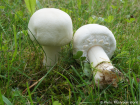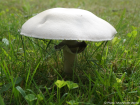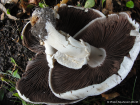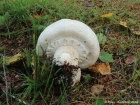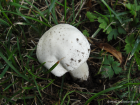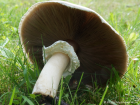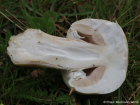Cap white or cream-coloured, may have fine scales, first hemispherical in shape before flattening out with maturity. The flesh is white, firm and thick. The cap turns yellowish where bruised, and old caps often take on a yellow-brown tinge. Gills are at first pale pink, becoming pink, then chocolate brown or blackish, free and crowded. Stem is white or cream, slightly club-shaped and smooth or finely scaly below the ring. The ring is white or cream, pendulous and superior. Viewed from below, on a closed-cap specimen, it may have a well-developed 'cogwheel' pattern around the stem. Spore print dark purple-brown.
Microscopic Features: The spores are ellipsoidal in shape, with a smooth surface and measuring approximately 6-9µm in length and 4-6µm in width.
Note: The mushroom called Horse mushroom in the USA is actually the closely related Agaricus fissuratus, which from a technical, scientific standpoint is a separate species. See Agaricus fissuratus on the MushroomExpert.Com web site.
Agaricus arvensis on the www.first-nature.com web site.
Many mushrooms are poisonous, and some can be lethally toxic. Distinguishing between edible and poisonous mushrooms can be very challenging. Therefore, we strongly advise against consuming wild mushrooms. This website does not contain any information about the edibility or toxicity of mushrooms.
Although efforts have been made to ensure accuracy on this website, the information may contain errors and omissions. Therefore, all content provided is for educational and informational purposes only and should not be relied upon or used as a basis for consuming any plants or mushrooms.
External links are provided for reference only. We do not endorse or take responsibility for the content, advice, or products found on these sites or in any advertisements shown on this website.
